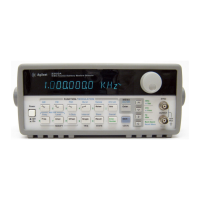DC Offset Voltage
For the offset parameter of the APPLy command, you can substitute
“
MINimum”, “MAXimum”, or “DEFault” in place of a specific value for
the parameter.
MIN selects the smallest dc offset voltage for the
selected function (0 volts).
MAX selects the largest offset for the
selected function. The default offset voltage is 0 volts for all functions.
You can set the offset to a positive or negative number with the
restrictions shown below. If the specified offset voltage is not valid,
the function generator will automatically adjust it to the maximum
dc voltage allowed with the present amplitude. (Vmax is the maximum
peak-to-peak amplitude for the selected output termination; Vpp is
the output amplitude in volts peak-to-peak.) From the remote interface,
a -221, “Settings conflict” error is generated and the offset is adjusted.
DC Offset and Output Termination: The offset voltage is auto-
matically adjusted (and no error is generated) if you change the
output termination. For example, if you set the offset to 100 mVdc and
then change the termination from 50 ohms to “high impedance”,
the displayed offset will double to 200 mVdc. If you change from “high
impedance” to 50 ohms, the displayed offset will drop in half.
See “Output Termination” on page 65 for more information.
For arbitrary waveforms, the Offset annunciator will turn on if the
waveform data has an inherent offset present (if the average is not
equal to zero). The function generator calculates the average of the
data points and compares the average to zero volts. If the average is
not within two
DAC (Digital-to-Analog Converter) counts of zero volts,
the
Offset annunciator turns on.
For dc volts, the output level is actually controlled by setting the
offset voltage. You can set the dc voltage to any value between
5 Vdc
into 50 ohms or
10 Vdc into an open circuit.
Ô
V
offset
Ô
+
V
pp
2
Vmax and
Ô
V
offset
Ô
2 x V
pp
Chapter 4 Remote Interface Reference
Using the APPLy Command
142

